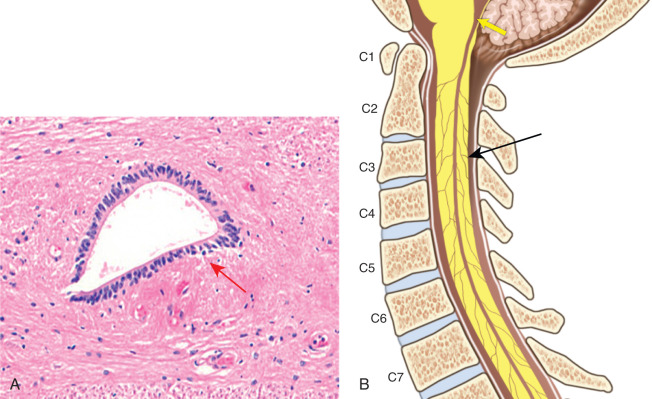Physical Address
304 North Cardinal St.
Dorchester Center, MA 02124
The term syringomyelia was introduced by the French pathologist and clinician Charles-Prosper Ollivier d'Angers in 1827 to described cystic cavities in the spinal cord. More specifically, hydromyelia refers to dilatation of the central canal lined by ependymal cells and syringomyelia refers to a cystic cord cavity separate from the central canal not lined by ependymal cells. This distinction has little practical importance as both entities appear similar on imaging and there can be disruption of the ependymal lining as hydromyelia enlarges.
The central canal can be thought of as a cul-de-sac where the only site of macroscopic communication with the subarachnoid space occurs at the obex. The central canal is lined by a single layer of columnar ependymal cells and appears oval in the axial plane ( Fig. 30.1 ). It is positioned slightly ventral of midline in the cervical and thoracic cord, at midline in the lumbar cord, and slightly dorsal of midline at the conus. Animal models suggest that cerebrospinal fluid (CSF) flows in a rostral direction within the central canal. However, dilation caudal to sites of obstruction is often not observed and sites of obstruction have been identified at autopsy in patients without syringohydromyelia. Consequently, there is speculation about the existence of microscopic channels positioned along the length of the cord providing communication between the central canal and subarachnoid space that likely need to be obstructed in order for syringohydromyelia to develop.

Syringohydromyelia can be classified into the following four categories based on etiology: hindbrain-related, posttraumatic/inflammatory, tumor-associated, and idiopathic. The incidence of syringohydromyelia ranges from 65% to 80% in Chiari I malformation and 35% in Chiari II malformation. The incidence of posttraumatic syringohydromyelia is 22%, with the interval between injury and diagnosis ranging from 2 months to 34 years. Postinflammatory syringohydromyelia has an incidence of less than 1% and is secondary to arachnoiditis or myelitis. The incidence of syringohydromyelia is 4.5% and 16% in patients with multiple sclerosis and neuromyelitis optica, respectively. The incidence of tumor-associated syringohydromyelia is 45%, highest with hemangioblastoma and ependymoma, and most commonly located superior to the tumor. Idiopathic syringohydromyelia has a 12% to 28% incidence, often no imaging or clinical progression, and may represent embryologic persistence of the central canal.
Syringohydromyelia characteristically presents with a dissociative sensory deficit of asymmetric loss of pain and temperature sensation in a cape-like distribution with preservation of vibratory and proprioception. Muscle atrophy, loss of deep reflexes, and scoliosis can be seen. Treatment is aimed at addressing the underlying cause and most commonly involves correcting osseous deformities or lysing adhesions. Catheter drainage is reserved for cases when normal CSF flow dynamics can no longer be restored.
Become a Clinical Tree membership for Full access and enjoy Unlimited articles
If you are a member. Log in here